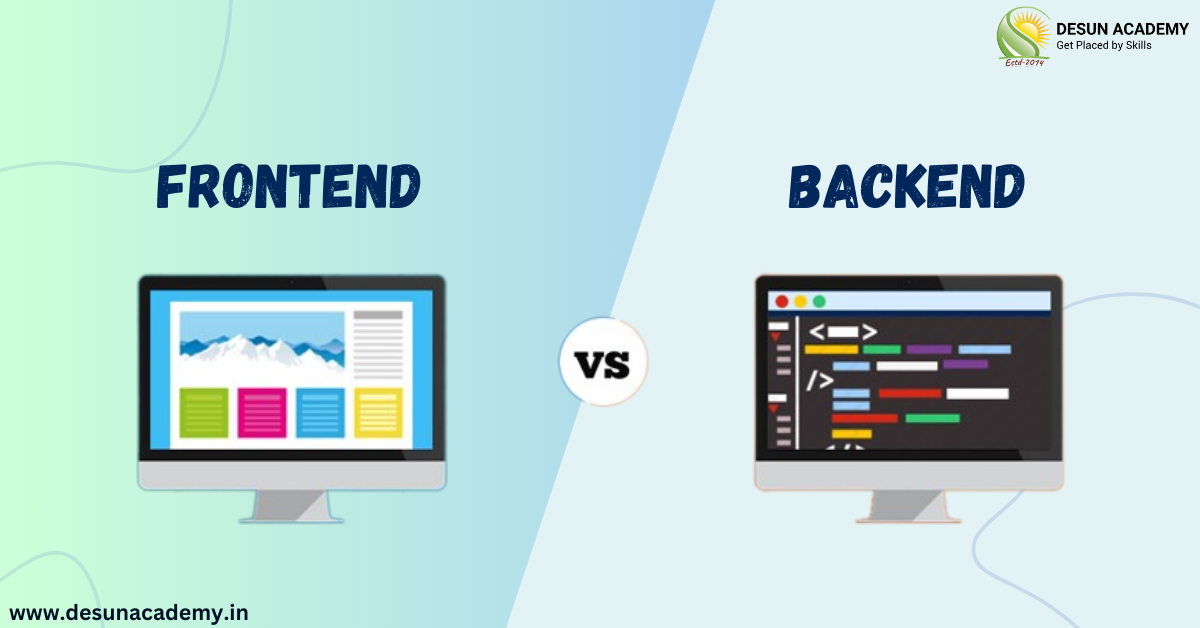
Backend Vs Frontend Web Development
Difference Between Backend and Frontend Web Development
In web development,frontend and backend are the two most frequently used phrases. Users interact and see the front end, but the backend powers the entire system. To increase the effectiveness of the website, both sides must properly communicate and work together as a single entity.
The front end of a website refers to the area where users interact with it directly. It consists of all the elements that users interact with directly, such as buttons, colors, styles and colors of text, graphics, tables, and graphs, and a navigation menu. Front-end development uses three languages: HTML, CSS, and JavaScript. Performance and responsiveness are the two primary goals of the front end.
Front End Development
Frontend development, also known as client-side development, is the process of creating the user interface and user experience of a website or web application. Frontend developers are responsible for building the parts of a web application that users interact with directly, such as the layout, design, and interactivity of a website.
Frontend Languages
The following languages are used in the construction of the front-end portion:
HTML:
Hypertext Markup Language is what HTML stands for. Using a markup language, it is used to design the front end of websites. HTML is a markup language and hypertext combination. The connection between web pages is known as hypertext. With the Geeksforgeeks Advanced HTML – Self-Paced course, you may study this language and gain mastery of advanced HTML principles.
CSS:
Cascading Style Sheets, or CSS for short, is a straightforward programming language that makes web page presentation easier. You can apply styles to web pages using CSS. Additionally, if you want to improve your abilities, sign up for the Geeksforgeeks CSS Foundation – Self-Paced course to discover the latest CSS ideas.
JavaScript:
JavaScript is a well-known programming language that is used to work magic on websites to make them interactive for users. It’s used to improve a website’s functionality so that exciting games and web apps can run on it. Javascript, useful in both front-end and back-end development, is essential to become a skilled developer. So enroll in Geeksforgeeks JavaScript Foundation: A Self-Paced Course today to begin your web development career.
Depending on the framework, front-end development can be done in a variety of various languages. For instance, Flutter utilizes Dart, React uses JavaScript, Django uses Python, and many more.
Back End Development
The website’s server side is known as the backend. It organizes and maintains data and ensures that the client side of the website functions properly. It is a section of the website that is hidden from view and inaccessible. It’s the part of the program that doesn’t interact directly with users. Through a front-end application, users can indirectly access the features and components created by backend designers. The backend also includes tasks like writing APIs, building libraries, and interacting with system components devoid of user interfaces or even scientific programming systems.
Backend Languages
Several languages are used in the construction of the back-end, as will be covered below:
1. PHP:
PHP is a scripting language that runs on servers that are specifically intended for web development. PHP is referred to as a server-side scripting language since its code runs on the server side.
2. C++:
These days, a lot of people utilize this general-purpose programming language for competitive programming. It’s employed as a backend language as well. Therefore, if you’re interested in studying C++, you may easily pick up the fundamentals of the language by enrolling in Geeksforgeeks C++ Programming Foundation – Self-Paced course.
3. Java:
One of the most well-liked and extensively utilized platforms and programming languages is Java. It has great scalability. Java is one of the most popular languages, and Geeksforgeeks offers a self-paced course called Java Programming Foundation that can help you learn the language effortlessly. It will assist you in comprehending the appropriate structure, ideas, purposes, and more.
4. Python:
Python is a programming language that facilitates faster work and more effective system integration. Python is a crucial language for the back end as well. If you want to learn it, check out the Python Programming Foundation – Self-Paced course. This course is suitable for beginners and will assist you in developing a solid foundation in Python.
5. Node.js:
An open-source, cross-platform runtime environment called Node.js allows JavaScript code to be executed outside of a browser. Recall that NodeJS is not a programming language, nor is it a framework. Though most are perplexed, they realize that it’s either a programming language or a framework. When developing back-end services like APIs for web apps or mobile apps, Node.js is frequently used. Big corporations like Paypal, Uber, Netflix, Walmart, and others use it in their manufacturing.
Conclusion:
Coding Courses provided by Desun Academy are your ticket to success whether you’re getting ready 4 your first job interview or trying to upskill in this always-changing IT industry. We offer premium information at reasonable costs, all intending to hasten your advancement within a specific time frame. Join the millions of people we’ve previously empowered; we can help you do the same. Don’t hesitate to check it out right away!
Here you can have both theoretical and practical training from expert corporate professionals. Who have 9 years of experience, and also you can get the opportunity to work on many live projects. Which will help you to gain hands-on experience.
To know more visit us.








